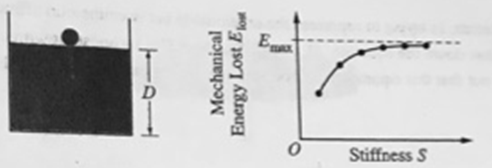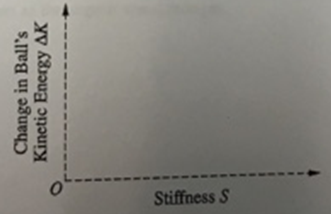Food scientists have created a new oil. At room temperature, the oil is a liquid. As the oil gets colder however, it stiffens (thickens) into
Food scientists have created a new oil. At room temperature, the oil is a liquid. As the oil gets colder however, it stiffens (thickens) into a sticky gel.

To explore the properties of the oil, the scientists fill a container with the oil to a height D, as shown in the figure above on the left. They drop a small steel ball of mass M from rest at top of the oil. Using video to capture the ball's motion, the scientists calculate E lost , the mechanical energy lost by the ball-Earth system from the time the ball enters the oil to the time just before the ball strikes the bottom of the container.
The scientists also define the "stiffness" S of the oil as a quantity proportional to the force required to move a rod through the oil at a standard constant speed. the scientists calculate E lost and S at several different temperatures, ranging from room temperature to the lowest temperature at which the ball still falls through the oil. The graph above on the right shows E lost as a function of S for the calculated data points and a best-fit curve.
(a) Give a physical reason why the curve in the graph would not reach the vertical (E lost ) axis even if the scientists had take data over a broader range of temperatures.
(b) As S increases, E lost approaches a maximum value labeled E max on the graph above. Write an equation for E max in terms of M.D, and physical constants, as appropriate.
Justify your answer.
(c) One of the scientists, in trying to represent the relationship between the oil stiffness and the mechanical energy lost, writes down the equation E lost = CS 2 , where C is a constant with appropriate units. Another scientist points out that this equation cannot be correct. Give two reasons why the equation cannot be correct.
(d) Further attempting to model the ball's motion, the scientists write the following equation for the time t the ball takes to fall through the oil: t = Z/S, where Z is a constant with appropriate units. Is this equation plausible - in other words, does it make physical sense?
___ Plausible _______ Not plausible
Briefly explain your reasoning.
(e) ?K is the change in kinetic energy of the ball between the time it is released from rest and the time just before the ball strikes the bottom of the container. On the axes below, sketch ?K as a function of S, the oil stiffness.

Stiffness S Mechanical Energy Lost Elo Ex Stiffness S 1 1 1 I I I Change in Ball's Kinetic Energy AK
Step by Step Solution
3.26 Rating (149 Votes )
There are 3 Steps involved in it
Step: 1
a Oil has a viscous nature which is nothing but the frictional forces acting between the layers of t...
See step-by-step solutions with expert insights and AI powered tools for academic success
Step: 2

Step: 3

Ace Your Homework with AI
Get the answers you need in no time with our AI-driven, step-by-step assistance
Get Started


